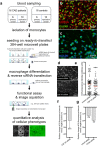Systematic RNA-interference in primary human monocyte-derived macrophages: A high-throughput platform to study foam cell formation
- PMID: 30002403
- PMCID: PMC6043567
- DOI: 10.1038/s41598-018-28790-3
Systematic RNA-interference in primary human monocyte-derived macrophages: A high-throughput platform to study foam cell formation
Abstract
Macrophage-derived foam cells are key regulators of atherogenesis. They accumulate in atherosclerotic plaques and support inflammatory processes by producing cytokines and chemokines. Identifying factors that regulate macrophage lipid uptake may reveal therapeutic targets for coronary artery disease (CAD). Here, we establish a high-throughput screening workflow to systematically identify genes that impact the uptake of DiI-labeled low-density lipoprotein (LDL) into monocyte-derived primary human macrophages. For this, monocytes isolated from peripheral blood were seeded onto 384-well plates, solid-phase transfected with siRNAs, differentiated in vitro into macrophages, and LDL-uptake per cell was measured by automated microscopy and quantitative image analysis. We applied this workflow to study how silencing of 89 genes impacts LDL-uptake into cells from 16 patients with CAD and 16 age-matched controls. Silencing of four novel genes (APOC1, CMTM6, FABP4, WBP5) reduced macrophage LDL-uptake. Additionally, knockdown of the chemokine receptor CXCR4 reduced LDL-uptake, most likely through a G-protein coupled mechanism that involves the CXCR4 ligand macrophage-induced factor (MIF), but is independent of CXCL12. We introduce a high-throughput strategy to systematically study gene function directly in primary CAD-patient cells. Our results propose a function for the MIF/CXCR4 signaling pathway, as well as several novel candidate genes impacting lipid uptake into human macrophages.
Conflict of interest statement
H.R. is a full-time employee of Biogen, Inc.
Figures



References
Publication types
MeSH terms
Substances
LinkOut - more resources
Full Text Sources
Other Literature Sources
Medical
Research Materials
Miscellaneous

